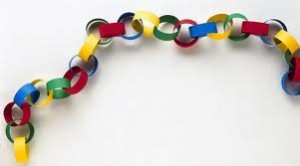 As Christmas approaches I was thinking about a way I could get some nice decorations made for my classroom in a way that would also help my Year 11s to learn something. The result was “Argument Chains”, a version of a simple paper chain that also visually represents a written argument.
As Christmas approaches I was thinking about a way I could get some nice decorations made for my classroom in a way that would also help my Year 11s to learn something. The result was “Argument Chains”, a version of a simple paper chain that also visually represents a written argument.
Who's it for? Anyone involved in a subject that requires students to write essays.
Outline of the idea: The paper chain represents an argument in that each “link” connects together to make a “chain” just as each sentence of an essay should link to the next in order to make an argument. By putting together the argument as a paper chain (with a section of the argument on each link) the students create a visual representation of the argument and you also get something nice to put up at Christmas time into the bargain!
I developed the idea by using different coloured paper for each “part” of an argument. One colour for “introduction”, another for the “key point” in a PEE-based paragraph, another for “evidence”, “explanation”, “discussion”, “conclusion” etc. This forces the students to think about what purpose each sentence in their argument fulfils. (I insisted that they make a separate “link” for each individual sentence). They then write each sentence of their argument onto an appropriately coloured “link” and then join them together to make their chain at the end. I also encouraged them to use a blank white link to represent the start of a new paragraph.
Students can then look at each other's chains in order to assess how well-structured their arguments are. For example, it quickly becomes clear if your argument has no evidence!
How it worked: Once students had got the idea they quickly got down to work on their chains. I had them working in pairs so they could discuss which colour they needed to use. They were keen to make their “chain” as strong as possible. It was a useful aid for discussion about what makes a good essay. Be warned though, it did take my Year 12s a long time!
Preparation: All you'll need to do is raid the stationery cupboard for a range of coloured paper and make sure you have rulers, scissors and glue. It might also be worth preparing a suitable essay title in advance so the discussion can stay on structure without having problems coming up with content.
Next Steps: I haven't tried this yet but I wonder whether this might be adapted for less-able students who struggle with essay structure. Give them some model answers and ask them to translate it onto a paper chain so they can start to assess what role different parts of the essay play. It may even be worth having some good and some weaker model answers for them to use. Once the chains are created you'll be able to use them to discuss which answers are good by looking for those that have evidence, explanation, discussion etc.
Good luck. Please leave any comments if you have ideas or questions!
Update:
I've found that this works well when you have a model answer prepared and students have to convert it into paper-chain format by analysing which part of an essay each sentence contributes to.